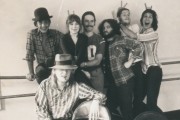 I was awarded the opportunity to see Silent House, the American remake of Uruguayan director Gustavo Hernandez’s 2010 horror flick La Casa Muda. The South American original made headlines due to it being shot entirely in “one long take.” The update is helmed by a pair of directors, Chris Kentis (Open Water) and Laura Lau (Open Water/Grind), with the latter also serving as the film’s writer.
I was awarded the opportunity to see Silent House, the American remake of Uruguayan director Gustavo Hernandez’s 2010 horror flick La Casa Muda. The South American original made headlines due to it being shot entirely in “one long take.” The update is helmed by a pair of directors, Chris Kentis (Open Water) and Laura Lau (Open Water/Grind), with the latter also serving as the film’s writer.
Silent House stars Elizabeth Olsen (Martha Marcy May Marlene) as Sarah, the twentysomething daughter of John (Adam Trese) and niece of Peter (Eric Sheffer Stevens). Hm, biblical names much? The three are cleaning up and preparing the family’s vacation home to be sold off. The house’s electricity is shut off, requiring candles and lanterns to provide lighting as the characters pack up trinkets and deal with the inevitable mold from years without due maintenance. John and Peter get into an argument over something and Uncle Peter leaves for town in a huff; Sarah and John remain to continue the festivities. The two separate so that Sarah can get to cleaning her old room, when a sudden thump and the disappearance of John catalyze Sarah into venturing out and discovering the house’s sinister secrets. Sarah spends a solid hour getting chased by a masked man in heavy boots and the ghostly spectre of a young girl until the house’s dark past is finally revealed in a twisty little ending.
Ultimately, Silent House is as standard a haunted house flick as it gets, with a breathy young damsel, an unseen demon, and jump scares galore from either LOUD NOISES or suspicious visions. The film’s marketing aim is to highlight the “real-time” aspect. Silent House clocks in at a brisk 88 minutes, 97% of which have Olsen entirely in frame, and utilizes the “one long shot/take” that the original offered. Unlike Hernandez’s La Casa Muda, which hid the edits exceedingly well (only one pitch black spot in the film gave a good opportunity to cut), this version has some rather obvious spots where match edits and minor effects sever the digital filmstrip. It’s not a bad thing, as it increases the production value slightly and the visceral, voyeuristic effect is one of the film’s better traits. Truly following our protagonist for a complete hour and a half creates a neat window in which we see the events unfold. However, anyone paying attention to camerawork and scene geography will quickly notice the lapses in realtimeyness at various points.
 The main issue with Silent House is its inability to bring anything new to the genre other than the attempt at real-time filmmaking. The script, and by proxy, Sarah, falls into every known trope and cliché that the genre holds dear. She visits the top floor, then she gets chased, then she needs a key, then she visits the basement… It’s all well-tread territory and the fact that Sarah is in your face the whole time means not a single trite plot point will make it past your skepticism. Sarah’s journey through the house is an exercise in finding objects to hide beneath — as well as futility — and it gets to be exhausting. By the time she escapes the house and then goes back inside, I was holding down a groan. At long last, the film’s climax arrives along with the grand plot twist and… it’s one we’ve seen before in a bunch of variations. Sigh. The intense, but not-entirely-unexpected reveal introduces a logical fallacy or three, as twists of this nature always do. At its best, Silent House is utterly formulaic and at its worst, the film is a little boring. That’s unusual considering the efficient runtime and style of shooting.
The main issue with Silent House is its inability to bring anything new to the genre other than the attempt at real-time filmmaking. The script, and by proxy, Sarah, falls into every known trope and cliché that the genre holds dear. She visits the top floor, then she gets chased, then she needs a key, then she visits the basement… It’s all well-tread territory and the fact that Sarah is in your face the whole time means not a single trite plot point will make it past your skepticism. Sarah’s journey through the house is an exercise in finding objects to hide beneath — as well as futility — and it gets to be exhausting. By the time she escapes the house and then goes back inside, I was holding down a groan. At long last, the film’s climax arrives along with the grand plot twist and… it’s one we’ve seen before in a bunch of variations. Sigh. The intense, but not-entirely-unexpected reveal introduces a logical fallacy or three, as twists of this nature always do. At its best, Silent House is utterly formulaic and at its worst, the film is a little boring. That’s unusual considering the efficient runtime and style of shooting.
There are glimmers of hope in the movie, in the form of slick lighting, smart sound mixing, and one sequence that is lifted from the original and given a nice updated treatment. At one point, a generator providing light to a room goes unexpectedly dark. Sarah is forced to use the flash of a Polaroid camera to navigate her way through the halls until she can find a new light source. The brief segment is a pretty sweet thrill and serves as an homage to the original’s Polaroid-based plotline and a parallel to the plotline of this new one. Additionally, the film’s reliance on candle-based and electric lantern light lends itself to the overall ambience and creates a dark, unexplored frame in which to spook us. We are unable to see beyond the veil of Sarah’s vision thanks to clever camera placement and shadowy environs, often drawing the eye to eerie negative space or creepy, cluttered backgrounds. Horror films also tend to showcase great audio work and Silent House should not disappoint. It of course has the jump scares that plague the genre, but much of the sound design is subtle in the way that it plays with noise and expectations. The soundtrack is reminiscent of that of Ti West’s The House of the Devil, leading to us really feel the titular silence of the home.
I must admit, I have a little crush on Elizabeth Olsen after Martha Marcy May Marlene, but even without that, Olsen out-acts the hell out of everyone in the movie. She isn’t given much to work with scriptwise, but when she works, she really works. There’s only so much heavy breathing, sobbing, and gasping a horror heroine can do; even so, Olsen is well-suited for material a bit deeper and more engrossing than this.
I’m a snob about most things and the horror genre is no exception. I tend to only enjoy the ones that end with “-ing”: The Thing, The Ring, The Exorcist…ing. Silent House simply does not have enough oomph, depth, or creativity to impress me in a genre that has been drained of all but the most elusive ingenuity. (If it were only called Silent Housing…) The real-time gimmick and stellar audiovisual work cannot overwhelm the hopelessly obvious tropes, repetitive chases, and the convenient, unsurprising twist ending. I can see Silent House as having the gimmicky appeal of Paranormal Activity, but not the decent critical appeal of Insidious as it opens wide against Disney’s monster John Carter on March 9th.
Rating: It’s for fans of haunted houses and poorly planned first dates only. (3/10)















Recent Comments